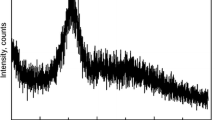Abstract
Thixoforming involves heating different types of alloys to the semisolid state at high heating rates and forming in die-casting machines or conventional presses. At temperatures higher than the solidus and lower than the liquidus, the mush metal behaves like a high-viscosity thixotropic material. Therefore, determining the thermodynamic behavior of the solid-to-liquid transition is paramount to control thixoforming processes. This article describes a simple, novel experimental setup based on differential thermal analysis (DTA) for analyzing the phase transitions in an alloy heated using high heating rates typical of industrial applications. A365 alloy was chosen to demonstrate the effectiveness of the method as the phase transformations for this alloy in semisolid materials (SSM) processing are well understood. Samples were heated to 750 °C using constant linear heating rates of 5, 10, 15, 20, 25, 50, 75, 100 and 125 °C min in a Norax 25 kW 8 kHz induction furnace with an Omron E5CK temperature controller. AISI 316 austenitic stainless steel was used as the inert reference. Comparison of the results of DTA using the proposed method and the results of simulation with Thermo-Calc® indicates that the proposed in situ DTA device and its method is suitable for analyzing phase transitions when high heating rates are used.










Similar content being viewed by others
References
Flemings MC. Behavior of metal alloys in the semisolid state. Metall Trans A. 1991;22(5):957–81. https://doi.org/10.1007/BF02661090.
Kirkwood DH, Suéry M, Kapranos P, Atkinson HV, Young KP. Semi-solid processing of alloys. Springer Series Materials Science; (2010), 124. https://doi.org/10.1007/978-3-642-00706-4.
Ferdian D, Lacaze J, Lizarralde I, Niklas A, Fernández-Calvo AI. Study of the effect of cooling rate on eutectic modification in A356 aluminium alloys. Mater Sci Forum. 2013;765:130–4. https://doi.org/10.4028/www.scientific.net/MSF.765.130.
Sekar K, Kanjirathikal A, Joseph MA. Comparison study of as-cast and T6 condition of microstructure, bending strength and double shear strength of A356 alloy by gravity, vacuum and squeeze casting. Appl Mech Mater. 2014;592–594:102–5. https://doi.org/10.4028/www.scientific.net/AMM.592-594.102.
Liu D, Atkinson HV, Jones H. Thermodynamic prediction of thixoformability in alloys based on the Al–Si–Cu and Al–Si–Cu–Mg systems. Acta Mater. 2005;53:3807–19. https://doi.org/10.1016/j.actamat.2005.04.028.
Zoqui EJ, Benati DM, Proni CTW, Torres LV. Thermodynamic evaluation of the thixoformability of Al–Si alloys. Calphad. 2016;52:98–109. https://doi.org/10.1016/j.calphad.2015.12.006.
León VLD, Valdés AF, Torres JT. Dilatometric and calorimetric studies on the phase transformations of the A380-type aluminum alloy during solidification and heat treatment. J Therm Anal Calorim. 2017;130:1751. https://doi.org/10.1007/s10973-017-6548-1.
Farahany S, Ourdjini A, Idris MH. The usage of computer-aided cooling curve thermal analysis to optimise eutectic refiner and modifier in Al–Si alloys. J Therm Anal Calorim. 2012;109:105–11. https://doi.org/10.1007/s10973-011-1708-1.
Alexandrov B, Lippold J, Tatman J, Murray G. Non-equilibrium phase transformation diagrams in engineering alloys. In: Trends in welding research, proceedings of the 8th international conference; (2008) p. 467–476. https://doi.org/10.1361/cp2008twr467.
Klančnik G, Medved J, Mrvar P. Differential thermal analysis (DTA) and differential scanning calorimetry (DSC) as a method of material investigation. RMZ Mater Geoenviron. 2010;57(1):127–42.
Oliveira A, Freire RCS, Deep GS, Barros PR. A digital differential thermal analysis instrument. Measurement. 1998;23:47–54. https://doi.org/10.1016/S0263-2241(98)00008-6.
Wendlandt WW. The development of thermal analysis instrumentation 1955–1985. Thermochim Acta. 1986;100:1–22. https://doi.org/10.1016/0040-6031(86)87048-4.
Chen SW, Huang CC. The relationship between the peak shape of a DTA curve and the shape of a phase diagram. Chem Eng Sci. 1995;50(3):417–31. https://doi.org/10.1016/0009-2509(94)00244-L.
Cheng SZD, Li ChY, Calhoun BH, Zhu L, Zhou WW. Thermal analysis: the next two decades. Thermochim Acta. 2000;355:59–68. https://doi.org/10.1016/S0040-6031(00)00437-88.
Alexandrov BT, Lippold JC. In situ determination of phase transformations and structural changes during non-equilibrium material processing. In: Kannengiesser et al. (eds.) In-situ studies with photons, neutrons and electrons scattering; (2010). p. 113–131. https://doi.org/10.1007/978-3-642-14794-4_8.
Martinez LM, Videa M, Mesquita J. Design, construction and calibration of a portable multi sample DTA setup. Thermochim Acta. 2013;560:89–94. https://doi.org/10.1016/j.tca.2013.03.016.
Gong X, Guo Z, Wang Z. Variation on anthracite combustion efficiency with CeO2 and Fe2O3 addition by differential thermal analysis (DTA). Energy. 2010;35:506–11. https://doi.org/10.1016/j.energy.2009.10.017.
Brollo GL, Proni CTW, de Paula LC, Zoqui EJ. An alternative method to identify critical temperatures for semisolid materials process applications using differentiation. Thermochim Acta. 2017;651:22–33. https://doi.org/10.1016/j.tca.2017.02.010.
Farahany S, Ourdjini A, Idris MH, Shabestari SG. Computer-aided cooling curve thermal analysis of near eutectic Al–Si–Cu–Fe alloy. J Therm Anal Calorim. 2013;114:705–17. https://doi.org/10.1007/s10973-013-3005-7.
Flynn JH. Analysis of DSC results by integration. Thermochim Acta. 1993;217:29–149. https://doi.org/10.1016/0040-6031(93)85104-H.
Proni CTW, Robert MH, Zoqui EJ. Effect of casting procedures in the structure and flow behaviour of semisolid A356 alloy. Arch Mater Sci Eng; (2015);73 2:82–93. http://www.amse.acmsse.h2.pl/vol73_2/7324.pdf.
Moradi M, Ahmadabadi MN, Poorganji B, Heidarian B, Furuhara T. EBSD and DTA characterization of A356 alloy deformed by ECAP during reheating and partial re-melting. Metall Mater Trans A. 2014;45A:1540–51. https://doi.org/10.1007/s11661-013-2093-0.
Kumar SD, Mandal A, Chakraborty M. Solid fraction evolution characteristics of semi-solid A356 alloy and in situ A356–TiB2 composites investigated by differential thermal analysis. Int J Miner Metall Mater. 2015;22(4):389–94. https://doi.org/10.1007/s12613-015-1084-0.
Acknowledgements
The authors would like to thank CAPES (Federal Agency for the Support and Evaluation of Postgraduate Education, Brazil) (CAPES/MES-Cuba Program, Project No. 095/2010), CNPq (National Council for Scientific and Technological Development, Brazil) (CNPq PQ Grant No. 306896-2013-3) and FAPESP (São Paulo Research Foundation) (Project No. 2015/22143-3) for providing technical and financial support. The authors are also indebted to the Faculty of Mechanical Engineering at the State University of Campinas for the practical support very kindly provided.
Author information
Authors and Affiliations
Corresponding author
Rights and permissions
About this article
Cite this article
Roca, A.S., Fals, H.D.C. & Zoqui, E.J. In situ differential thermal analysis device for evaluating high-speed phase transitions. J Therm Anal Calorim 134, 1589–1597 (2018). https://doi.org/10.1007/s10973-018-7629-5
Received:
Accepted:
Published:
Issue Date:
DOI: https://doi.org/10.1007/s10973-018-7629-5




